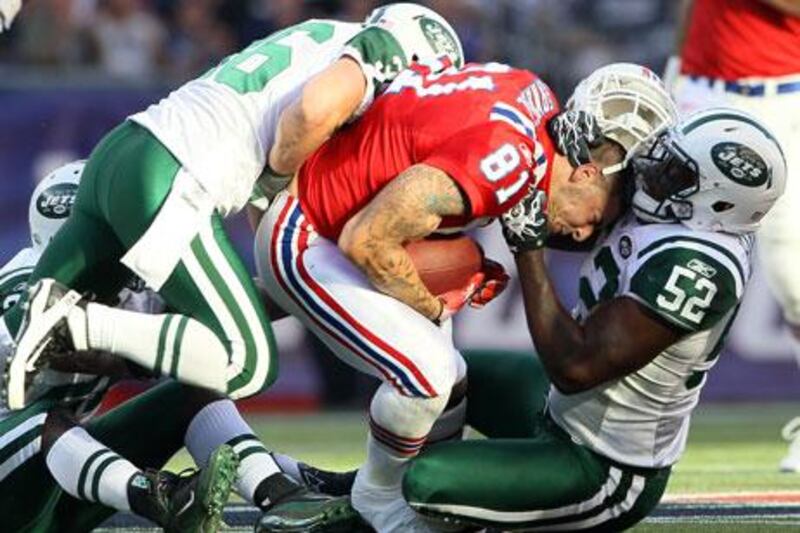The revolution has begun for America's popular collision sports.
American football and ice hockey are altering the core of their games in the laudable interest of player safety. They have dialled down the violence with policy changes and, in some cases, with hard hits of their own - on athletes' wallets.
Rule makers and enforcement staff with the NFL and NHL bear no greater responsibility than shaping an environment that enables a player to retire - voluntarily or not - with his wits about him and body parts in working order.
They are burdened with a task more challenging than any in sports governance. Each league is about strong, fast men engaging in high-speed crashes. Without them, the sports become something other than football and hockey. They are part of the fabric, but the fabric can be smoothed out with regulations that inhibit vicious contact.
One year ago today, the NFL set the tone by severely fining James Harrison, Dunta Robinson and Brandon Meriweather for what it termed devastating hits.
For the rest of last season, miscreants were called out by the league as routinely as the release of the injury report.
There is such a narrow divide between legal and illegal, physical and brutal, that the NFL inevitably will find fault in a borderline case and issue a fine that might seem harsh. There might be some innocents who get caught up in the crackdown.
So what? Players who make a living on crushing the vulnerable, particularly with their helmets, must go with the flow or wash out of the league.
Harrison, a serial extreme hitter whose four fines last season cost him US$125,000 (Dh460,000), went off on Roger Goodell in a magazine article over the summer, saying he would have told the hard-line commissioner: "Why don't you quit and do something else, like start your own league in flag football?"
The Pittsburgh Steelers linebacker had the good sense later to express regret over his comments.
Most players have taken heed - fines are down this season and no cheap shots have warranted suspension - but not everyone. Robinson laid out the Philadelphia Eagles' DeSean Jackson and was worse off by $40,000.
Darrel Young, the Washington Redskins fullback, docked for a block on a defenceless opponent during a punt return, said: "I think … it's not football anymore. Guys are getting, I feel, fined a little bit too much."
Deal with it. A 2009 study commissioned by the league found that retired players aged between 30 and 49 struggle with memory loss at a rate 19 times greater than non-players. Anecdotal evidence abounds of former players becoming prematurely immobile.
The fines are, literally, a small price to pay.
Not until this season did hockey frown on unwarranted hits to the head. A new rule calls for a penalty on such a blow from any direction, instead of just lateral or blind side. Suspensions have increased. In the pre-season, nine players were punished by being forced to sit out a combined 31 regular season games.
More importantly, possibly concussed players are taken to a "quiet room" and examined by doctors, who must approve their return to the game.
The protocol offends old school types. The Washington Capitals' Brooks Laich was quoted in the Washington Times as saying: "To be honest, I'm sick of hearing all this talk about concussions and about the quiet room. This is what we love to do … Sometimes, it just feels like we're being babysat a little too much. We're grown men and we should have a little bit of say in what we want to do."
Laich must consider it a coincidence that three former NHL "enforcers", who are prone to concussions from fighting and ferocious hits delivered and received, died in the off-season from apparent suicide or drug overdose. The oldest was 35.
The imperative to reduce danger across the athletics spectrum was brought home at the weekend with the death of Dan Wheldon, the two-time Indianapolis 500 champion. His sport, motor racing, is like no other: each driver risks death simply by starting the engine and wheeling on to the track.
Advancements in safety, from the design of cars to the introduction of protective equipment, have been commendable. Still, before the Las Vegas 400, concerns were raised that race conditions made it ripe for a serious accident. An unusually large field of 34 cars was compressed on to a small 1.5-mile track whose layout might bunch them in an uncomfortably tight pack.
In the immediate aftermath, no blame was being assigned for the crash. But Jimmy Johnson, the Nascar multi-champion, lobbied for IndyCar to abandon the speedways and stick to road courses.
"I wouldn't run them on ovals," he said. "There's just no need to."
There is no need to cut corners on safety, in any sport. Let the penalties, fines and suspensions pile up until everyone is on board





